Fauna of New Zealand ニュージーランドの動物相シリーズ

鞘翅目
Fauna of New Zealand 61, Lucanidae (Insecta : Coleoptera).
No.61 クワガタムシ科
Holloway, B. A. 2007.
B5, 254pp. 価格:16,000円(税込17,600円)
図724点(うちカラー21pp.)+分布図39点、テキスト:英語
南半球には後翅の退化した特異なクワガタムシを多く産するが、ニュージーランドはとりわけユニークな種を産することで有名で、それほど広くない島国にもかかわらず39種ものクワガタを産する(35種は特産種で、それぞれ固有の5属に所属)。本書では7種もの新種記載もなされており、Geodorcus属などの後翅が退化した魅惑的な新種が、鮮明にカラー図示されている。フルカラーの全種の全形図以外に、触角、大鰓、口器、脛節、交尾器などの多数の描画があり、これだけ様々な部位が図示されていれば、本文を読む必要がないと思えるほどである。
当分野の第一人者による最新情報を網羅した文献であり、本書によってニュージーランド産クワガタムシに興味を持たれる方が激増することが予感される1冊。
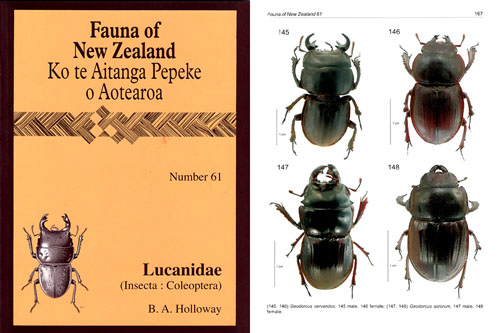
Abstract:
The morphology of New Zealand’s stag beetles (Insecta: Coleoptera: Lucanidae) is discussed and illustrated. New information is presented about the structure of the labium and profemoral setiferous patches in the family. All the genera and previously known species are redescribed and morphological structures including male and female genitalia are illustrated for the endemic species and, when appropriate, for the exotic species. The composition and relationships of the New Zealand lucanid fauna are discussed, and the known distribution and altitudinal ranges of the species are summarised and mapped. Habitats and the food of adults and larvae are discussed in general terms and in detail under each species. Keys for the identification of subfamilies, genera, and species of lucanids found in New Zealand are provided.
Thirtyfive endemic and 4 foreign species are recognised. They belong in 9 previously described genera representing 4 subfamilies: AESALINAE Holloceratognathus Nikolaev, 1998 (3 species), Mitophyllus Parry, 1843 (14 species); LAMPRIMINAE Dendroblax White, 1846 (1 species), Lamprima Latreille, 1807 (1 species); LUCANINAE Geodorcus Holloway, 1996 (10 species), Paralissotes Holloway, 1996 (7 species), Ryssonotus MacLeay, 1819 (1 species), Serrognathus Motschulsky, 1861 (1 species); SYNDESINAE Syndesus MacLeay, 1819 (1 species).
Seven new endemic species are described, 2 species are reinstated, and 1 species becomes a transferred synonym: AESALINAE: Mitophyllus angusticeps Broun, 1895, reinstated species, M. arcuatus new species, M. falcatus new species, M. fusculus (Broun, 1886) reinstated species, new combination, M. mandibularis Broun, 1917, transferred synonym of M. angusticeps Broun, 1895, M. solox new species; LUCANINAE Geodorcus alsobius new species, G. montivagus new species, G. servandus new species, G. sororum new species.
The 4 foreign species are: LAMPRIMINAE Lamprima aurata Latreille, 1817 (from Australia, probably not established); LUCANINAE Ryssonotus nebulosus (Kirby, 1818) (from Australia, established), Serrognathus sika (Kriesche, 1921) (from Taiwan, unlikely to be established), Syndesus cornutus (Fabricius, 1801) (from Australia, established).
The following 3 species are deleted from the New Zealand fauna: LUCANINAE: Figulus modestus Parry, 1863 (=F. fissicollis Fairmaire, 1849, from the Pacific, incorrectly labelled), Figulus monilifer (= F. sublaevis (Palisot de Beauvois, 1805), from Africa, incorrectly labelled), Lissotes desmaresti Deyrolle, 1881 (from Tasmania, incorrectly labelled; Holloway (1961) incorrectly treated L. desmaresti as a synonym of Dorcus (=Geodorcus) capito).
There is special concern for the survival of some of the large bodied, flightless species of Geodorcus that have been found only on islands or isolated mountain tops. These beetles should have the same status as flightless birds in the New Zealand biota and be given the equivalent protection from habitat destruction, rodent predation and unauthorised collectors
--------
Fauna of New Zealand 60. Carabidae (Insecta : Coleoptera): synopsis of supraspecific taxa
Larochelle, A.; Lariviere. 2007.
B5, 188pp. 5,100円
モノクロ全形図29ページ、モノクロ部分図12ページ、分布地図10ページ掲載。
テキスト:英語
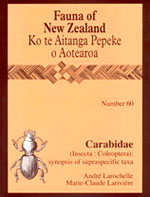
Abstract:
A synopsis of the New Zealand supraspecific taxa of Carabidae (Coleoptera) and an updated checklist of species-group taxa are presented.
Descriptions (subfamilies to subgenera), identification keys (subfamilies, tribes, and genera), habitus drawings (genera and subgenera), as well as distributional and ecological information, summaries of collecting techniques, and the most relevant bibliographic references for all genera, are provided. An appendix including a checklist of species updating the catalogue of Larochelle & Lariviere (2001, Fauna of New Zealand 43) is also provided.
The New Zealand carabid fauna currently includes 7 subfamilies, 21 tribes, 86 genera, and 476 species-group taxa (461 species, plus 15 subspecies). Fifty genera (58%) are currently recognised as being endemic; seventeen genera (20%) are native, and nineteen genera (22%) are adventive.
Three new genera and one new species are described: Kiwitachys new genus (type species: Tachys antarcticus Bates, 1874); Kiwitrechus new genus (type species: Kiwitrechus karenscottae new species); Kupetrechus new genus (type species: Duvaliomimus lamberti Britton, 1960). Three new generic synonymies are made (valid names listed after equal sign): Anomalobroscus Johns, 2007 = Diglymma Sharp, 1886; Taenarthrus Broun, 1914 = Loxomerus Chaudoir, 1842; Zabronothus Broun, 1893 = Cerabilia Laporte de Castelnau, 1867. Anchomenus Bonelli, 1810, is excluded from the New Zealand fauna. “Anchomenus” sensu White, 1846: 3 (and subsequent authors, especially Broun in many papers), nec Bonelli, 1810, is transferred to Ctenognathus Fairmaire, 1843. Twenty-one new combinations are established (valid names listed after equal sign): Anchomenus arnaudensis Broun, 1921 = Ctenognathus arnaudensis (Broun, 1921); Anchomenus colensonis White, 1846 = Ctenognathus colensonis (White, 1846); Anchomenus edwardsii (Bates, 1874) = Ctenognathus edwardsii (Bates, 1874); Anchomenus helmsi Sharp, 1881 = Ctenognathus helmsi (Sharp, 1881); Anchomenus integratus Broun, 1908 = Ctenognathus integratus (Broun, 1908); Anchomenus intermedius Broun, 1908 = Ctenognathus intermedius (Broun, 1908); Anchomenus libitus Broun, 1914 = Ctenognathus libitus (Broun, 1914); Anchomenus macrocoelis Broun, 1908 = Ctenognathus macrocoelis (Broun, 1908); Anchomenus oreobius Broun, 1886 = Ctenognathus oreobius (Broun, 1886); Anchomenus punctulatus Broun, 1877 = Ctenognathus punctulatus (Broun, 1877); Anchomenus sandageri Broun, 1882 = Ctenognathus sandageri (Broun, 1882); Anchomenus sophronitis Broun, 1908 = Ctenognathus sophronitis (Broun, 1908); Anchomenus sulcitarsis Broun, 1880 = Ctenognathus sulcitarsis (Broun, 1880); Anchomenus xanthomelus Broun, 1908 = Ctenognathus xanthomelus (Broun, 1908); Anomalobroscus seclusus Johns, 2007 = Diglymma seclusum (Johns, 2007); Duvaliomimus lamberti Britton, 1960 = Kupetrechus lamberti (Britton, 1960); Tachys antarcticus Bates, 1874 = Kiwitachys antarcticus (Bates, 1874); Tachys latipennis Sharp, 1886 = Kiwitachys latipennis (Sharp, 1886); Taenarthrus philpotti Broun, 1914 = Loxomerus philpotti (Broun, 1914); Zabronothus rufipes Broun, 1893 = Cerabilia rufipes (Broun, 1893); Zabronothus striatulus Broun, 1893 = Cerabilia striatula (Broun, 1893). The following synonymy is reinstated (valid names listed after equal sign): Zolus Sharp, 1886 = Oopterus Guerin-Meneville, 1841. Eight combinations are also reinstated (valid name listed after equal sign): Taenarthrus capito (Jeannel, 1938) = Loxomerus capito Jeannel, 1938; Zolus atratus Broun, 1893 = Oopterus atratus (Broun, 1893); Zolus carinatus (Broun, 1882) = Oopterus carinatus Broun, 1882; Zolus femoralis Broun, 1894 = Oopterus femoralis (Broun, 1894); Zolus helmsi Sharp, 1886 = Oopterus helmsi (Sharp, 1886); Zolus labralis Broun, 1921 = Oopterus labralis (Broun, 1921); Zolus ocularius Broun, 1917 = Oopterus ocularius (Broun, 1917); Zolus subopacus Broun, 1915 = Oopterus subopacus (Broun, 1915). Three adventive taxa are recorded for New Zealand for the first time: Adelotopus macilentus Baehr, 1997; Dromius meridionalis Dejean, 1825; Trigonothops pacifica (Erichson, 1842). The species Notagonum marginellum (Erichson, 1842) is deleted from the New Zealand fauna.
--------
Fauna of New Zealand 59 Erotylinae (Insecta : Coleoptera : Cucujoidea : Erotylidae) : taxonomy and biogeography
No.59 オオキノコムシ亜科
Skelly, P. & Leschen, R., 2007.
B5, 58pp. 3,100円
モノクロ全形図1ページ、モノクロ部分図2ページ、電子顕微鏡写真5ページ、分布地図2ページ掲載。
テキスト:英語
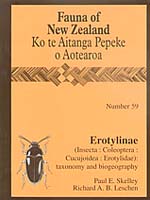
Abstract:
Erotylinae are also known commonly as the leasing fungus beetles・for their often striking colours, though these do not occur in New Zealand species. The 8 New Zealand erotyline species comprise a relatively small group, considering that nearby Australia has 50 species.
Erotylinae are represented in New Zealand by two genera, one of which is endemic. Various authors have described erotyline species, or created lists for them, but none has attempted to evaluate these taxa and update their taxonomy.
In Fauna of New Zealand 47, Rich Leschen restructured the family Erotylidae to include the family Languriidae, and examined the status of the higher taxa based on a cladistic analysis of adult characters. He also reviewed the New Zealand species that would have been included in the former family Languriidae. The purpose of this paper is to complement Leschen痴 review of New Zealand Erotylidae by covering the species of subfamily Erotylinae.
In this Fauna, the fungus-feeding Erotylinae fauna of New Zealand are revised and a key to the adults and illustrations of key characters for all species are presented.
Contributor Paul Skelley was born and raised in Illinois, USA. For his masters thesis at University of Florida he studied the Erotylidae of Florida, and his PhD dissertation was a revision of the genus Ischyrus Lacordaire north of Panama. While working on his PhD he took up a position in the Florida State Collection of Arthropods where he still works. His interests in beetles have focused on the Erotylidae, Aphodiinae (Scarabaeidae), and beetle natural histories in the south-eastern United States.
Contributor Rich Leschen was born in Arkansas, USA and raised in St Louis. He completed a Masters on fungus-feeding Coleoptera of Arkansas at the University of Arkansas and studied the systematics of Cryptophagidae at the University of Kansas. A curatorial assistant position at the Snow Entomological Museum gave him a broad training in the identification and systematics of world Coleoptera. Since joining Landcare Research he has maintained an interest in Coleoptera systematics.
Paul and Rich met by correspondence during their Masters studies and over the years they have collaborated on several projects on Erotylidae.
-------
Fauna of New Zealand 53. Harpalini (Insecta : Coleoptera: Carabidae: Harpalinae)
Larochelle, A.; Lariviere. 2005.
B5, 160pp. 5,200円
カラー前胸背図10ページ(56個体)、カラー全形図15ページ(56個体)、モノクロ全形図8ページ、モノクロ部分図10ページ、分布地図7ページ掲載。
テキスト:英語
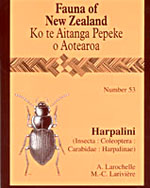
Abstract:
The New Zealand Harpalini fauna (Coleoptera: Carabidae: Harpalinae) is revised. Twenty genera and fifty-seven species are recognised. Five new genera are described: Maoriharpalus new genus and Tuiharpalus new genus (Anisodactylina), Hakaharpalus new genus and Kupeharpalus new genus (Pelmatellina), and Kiwiharpalus new genus (Stenolophina). The species Parabaris gourlayi Britton, 1964 is transferred to Tuiharpalus new genus. The original combination Harpalus australasiae Dejean, 1829 is reinstated. Tachys ( ) cavelli Broun, 1893 is transferred to the genus Hakaharpalus. Twenty-three new species are described: Anisodactylina Allocinopus belli new species, A. bousqueti new species, A. wardi new species, Maoriharpalus sutherlandi new species, Parabaris hoarei new species, P. lesagei new species, Tuiharpalus clunieae new species, T. crosbyi new species, T. hallae new species, T. moorei new species; Pelmatellina Hakaharpalus davidsoni new species, H. maddisoni new species, H. patricki new species, H. rhodeae new species, Kupeharpalus barrattae new species, K. embersoni new species, K. johnsi new species, Lecanomerus marrisi new species, Syllectus gouleti new species; Stenolophina Kiwiharpalus townsendi new species, Pholeodytes helmorei new species, P. nunni new species, and P. palmai new species . Eight new synonymies are established (valid name listed after equal sign): Allocinopus ocularius Broun, 1908 = Allocinopus sculpticollis Broun, 1903; Allocinopus castaneus Broun, 1912 = Allocinopus smithi Broun, 1912; Hypharpax abstrusus Bates, 1878 = Hypharpax australis (Dejean, 1829); Lecanomerus fallax Broun, 1880 = Lecanomerus insignitus Broun, 1880; Lecanomerus fuliginosus Broun, 1880, Lecanomerus pallipes Broun, 1894, and Lecanomerus incertus Broun, 1914 = Lecanomerus latimanus Bates, 1874; Syllectus spelaeus Britton, 1964 = Syllectus magnus Britton, 1964. Lectotypes are designated for the following taxa: Allocinopus smithi Broun, 1912; A. castaneus Broun, 1912; A. latitarsis Broun, 1911; Euthenarus brevicollis Bates, 1874; E. puncticollis Bates, 1874; Gaioxenus pilipalpis Broun, 1910; Harpalus antarcticus Laporte de Castelnau, 1867, H. novaezelandiae Laporte de Castelnau, 1867, Hypharpax abstrusus Bates, 1878; Lecanomerus fallax Broun, 1880; L. obesulus Bates, 1878; Syllectus anomalus Bates, 1878; Triplosarus fulvescens Bates, 1874. Four adventive species are recorded for New Zealand for the first time: Gnathaphanus melbournensis (Laporte de Castelnau, 1867); Notiobia quadricollis (Chaudoir, 1878); Euthenarus bicolor Moore, 1985; E. promptus (Erichson, 1842).
A concise revision of the taxonomy of all taxa is provided. Subtribes, genera, and species are keyed. Descriptions are provided with illustrations emphasising the most important diagnostic features of the external morphology and male genitalia. Information is given on synonymy, type data, material examined, geographic distribution, ecology, biology, dispersal power, and collecting techniques. The composition of the New Zealand Harpalini fauna, with endemism levels of 55% for genera and 75% for species, and its affinities with Australia, New Caledonia, Lord Howe Island, and Norfolk Island are analysed and discussed. Over 50% of native taxa (25 out of 42 species) are known from 10 populations or fewer and may be of potential conservation concern.
-------
Fauna of New Zealand 48. Scaphidiinae (Insecta : Coleoptera : Staphylinidae).
Loebl, I.; Leschen, R. A. B. 2003.
B5, 94pp. 3,800円
モノクロ部分図17ページ、電子顕微鏡写真5ページ、分布地図約23掲載。
テキスト:英語
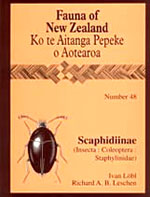
Abstract:
The 23 species of New Zealand scaphidiine Staphylinidae are revised and illustrated, with 1 genus and 15 species described as new. Cyparium is represented by 2 new species: C. earlyi n. sp. and C. thorpei n. sp. The originally monotypic genus Brachynopus now includes 4 species: B. apicellus (Broun) (new combination), B. latus Broun (= Baeocera fulvicollis Broun, new synonymy), Brachynopus rufus (Broun) (new combination; = Baeocera armata Broun, new synonymy), and Brachynopus scutellaris (Redtenbacher) (new combination; = Scaphisoma tenellum Pascoe, new synonymy; = Baeocera rufipes Broun, new synonymy). Notonewtonia n. gen. is described and includes 2 species: N. thayerae n. sp. (type species) and N. watti n. sp. The genus Baeocera includes 12 species: B. abrupta n. sp., B. actuosa (Broun) (new combination), B. benolivia n. sp., B. elenae n. sp., B. epipleuralis n. sp., B. hillaryi n. sp., B. karamea n. sp., B. punctatissima n. sp., B. sternalis Broun, B. tekootii n. sp., B. tensingi n. sp., and B. tenuis n. sp.. The genus Scaphisoma includes 3 species: S. hanseni n. sp., S. corcyricum Lobl (introduced from the Mediterranean), and S. funereum L?bl (introduced from Australia and established). A key is provided to all of the species and diagnoses for the higher taxa, including larval information where available.
Two genera are endemic to New Zealand ( Brachynopus and Notonewtonia ), whereas Baeocera and Scaphisoma are very diverse and distributed worldwide. Cyparium is rather restricted in distribution and is mainly circumtropical and absent from Australia and New Caledonia: the 2 rare New Zealand species are related to South African species. Although some species are rather widespread (most notably Brachynopus scutellaris and Scaphisoma hanseni ) other species are more regionally distributed. The centre for diversity of New Zealand species is in northern South Island where there are several similar-looking allopatric species of Baeocera . The most commonly collected species is the flightless Brachynopus latus that is found in many habitats, including pastures. Otherwise species are mainly forest dwelling and are taken most easily by leaf litter sifting or by hand collecting from host fungi. Rarely collected species, such as members of Cyparium (known from 3 specimens) and Notonewtonia (known from under 20 specimens), each genus with 2 species, may be indicative of certain microhabitats that are threatened and these species should be attributed conservation status.
Twelve of the 21 endemic New Zealand species are flightless, and island members of Brachynopus scutellaris are brachypterous or apterous. Scaphidiines are strictly fungus feeding and are found on Polyporacaea, Corticiacaea, and Myxomycetes. Brachynopus species are found breeding mainly on resupinate corticioid and polyporoid Basidiomycetes where larvae build canopy retreats. Species of Baeocera are associated mainly with Myxomycetes whereas adults of Scaphisoma hanseni are found commonly on Phellinus kamahi.
--------
Fauna of New Zealand 47. Erotylidae (Insecta : Coleoptera : Cucujoidea) : phylogeny and review
No.47 オオキノコムシ科
Leschen, R.A.B., 2003.
B5, 108pp. 4,300円
モノクロ全形図2ページ、モノクロ部分図5ページ、電子顕微鏡写真9ページ掲載。
テキスト:英語
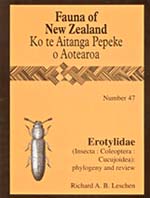
Abstract:
This contribution treats the nine species of the New Zealand Erotylidae, a small family considering there are approximately 3500 species worldwide. In New Zealand there has been little research into this family of beetles, perhaps because they tend to be mostly small and brown, though elsewhere they can be big and beautiful.
Part of this contribution proposes an amended classification for the world fauna of Erotylidae, by erecting two new tribes, describing two new genera, and making changes to generic status and family placement. How the New Zealand members of Erotylidae fit into this new classification is of primary importance for understanding the origins of our local fauna and how they relate to other erotylids. It also considers the phylogenetic or family relationships which the New Zealand species have with erotylid beetles throughout the rest of the world, such as Australia, New Caledonia, South America, and possibly South Africa.
The family can be easily separated from other groups, but a microscope will be necessary to discriminate these species from similar families such as Cryptophagidae. The identification keys which are supplied with this Fauna will help. The species are not difficult to identify, some having distinctive colour patterns that make for easy recognition. New Zealand fauna reflects the mixture of feeding types which make up the erotylid family, some feeding on fungus, others on plants and the remainder being scavengers feeding on plant and fungus tissues.
Annotated keys to the higher taxa and genera of all subfamilies except Erotylinae and Languriini are provided and biological information, including cycad feeding and mycophagy, is summarised.
Contributor Rich Leschen was born in Arkansas, USA and raised in St Louis. He completed a Masters at the University of Arkansas and studied the systematics of Cryptophagidae at the University of Kansas. A curatorial assistant position at the Snow Entomological Museum gave him a broad training in the identification and systematics of world Coleoptera. Since joining Landcare Research he has maintained an interest in Coleoptera systematics and an involvement with the local and international beetle community. His main objective is to produce useful beetle classifications and to promote the study of natural history.
-------
Fauna of New Zealand 45. Nemonychidae, Belidae, Brentidae (Insecta : Coleoptera: Curculionoidea).
Kuschel, G. 2003.
B5, 100pp. 4,000円
モノクロ全形図3ページ、モノクロ部分図19ページ、分布地図5ページ掲載。
テキスト:英語
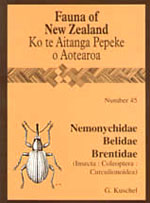
Abstract:
The curculionoid families Nemonychidae, Belidae, and Brentidae are revised: Nemonychidae comprising 4 species in 1 genus; Belidae 6 species in 4 genera; and Brentidae 7 species in 6 genera (including 1 species introduced for biological control). The Nemonychidae and the 5 species of Belinae are associated with the conifer families Podocarpaceae and Phyllocladaceae, the species of Aglycyderinae with Araliaceae, the winged native Apioninae with Cupressaceae, Fagaceae, and Myrtaceae, and the introduced Apioninae with Fabaceae (Ulex). The species of Brentinae lives in dead wood of various dicotyledonous trees, and the host of the flightless apionine remains unknown. Introductory sections deal with faunal richness, composition, fossil families of Curculionoidea, biogeography, and deposition of types and other specimens. A further section completes information on female pouches and rectifies a past error on the nature of some of these.
Four new genera proposed are: Rhicnobelus n.gen. (Belidae, type-species Pachyura metallicus Pascoe), Zelapterus n.gen. (Brentidae: Apioninae, type-species Apion terricola Broun), Cecidophyus n.gen. (Apioninae, type-species C. nothofagi n.sp.), and Strobilobius n.gen. (Apioninae, type-species S. libocedri n.sp.). Agathinus Broun is removed from synonymy with Cyrotyphus Pascoe. Six new species are erected: Rhinorhynchus halli n.sp., R. halocarpi n.sp., R. phyllocladi n.sp., Cecidophyus nothofagi n.sp., Strobilobius libocedri n.sp., and Neocyba regalis n.sp.. There are 4 new combinations proposed: Rhicnobelus aenescens (Broun), R. metallicus (Pascoe), and R. rubicundus (Broun) are transferred from Pachyura to Rhicnobelus; and Z. terricola (Broun) is transferred from Apion to Zelapterus. New synonymies are: Pachyura albocoma (Broun), P. brookesi (Broun), P. sumptuosus (Broun), and P. venustus (Broun) are synonymised with Rhicnobelus metallicus (Pascoe); and Pachyura pilosus (Broun) and P. violaceus (Broun) are synonymised with Rhicnobelus rubicundus (Broun).
The ratios for weevil groups on conifers with straight vs geniculate antennae (Orthoceri over Gonatoceri) show markedly different percentages in the northern and southern hemispheres. The percentage of conifer-associated Orthoceri over Gonatoceri is 63% in New Zealand, 61% in Australia, 52% in Chile, and only 2.5% in Europe. It is estimated that the New Zealand weevil fauna amounts to approximately 1800 species. It currently numbers 1500 validly established names, but about one-quarter of these are expected to fall into synonymy. Of the six recognised orthocerous families, Attelabidae and Caridae are not represented. The Anthribidae, Aglycyderinae (Belidae), and Apioninae (Brentidae) are most closely related to the fauna of New Caledonia, Belinae with Australia, and Nemonychidae with Chile. The early fossil fauna is summarised with comments on the status of four weevil families based on strata imprints. The phylogenetic relationships of 28 terminal taxa of Belinae are discussed in Appendix 1, and the genus Atractuchus is synonymised with Dicordylus.
-------
Fauna of New Zealand 43. Carabidae (Insecta : Coleoptera): catalogue
Larochelle, A.; Lariviere, M.-C. 2001
B5, 285pp. 6,900円
モノクロ全形図6ページ、モノクロ部分図19ページ、分布地図48ページ掲載。
テキスト:英語
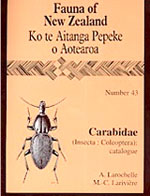
Abstract:
The species-group names of all New Zealand Carabidae (including Cicindelini) are catalogued with distribution records and information on ecology, biology, and dispersal power. Valid names are listed in their current and original combinations with the author(s), publication date, page citation, and type locality; synonyms are given in their original combinations; other existing combinations are also provided. Genus-group names are listed with the author(s), publication date, page citation, and type species (including method of fixation). The catalogue is arranged phylogenetically by subfamilies, divisions, tribes, and subtribes. Genus- and species-group names are listed alphabetically within these categories. The most important references dealing with taxonomy (including keys and revisions), distribution, ecology, biology, and dispersal power, are provided as appropriate.
The catalogue also includes a bibliography of all original descriptions and of most important references consulted, a habitus illustration of one representative of each tribe, maps showing species distribution, patterns of taxonomic diversity and of species endemism, and also a full taxonomic index. Finally, a number of appendices are provided: a glossary of technical terms, a list of nomina nuda, a list of unjustified emendations, a synopsis of species incorrectly or doubtfully recorded, a synopsis of species deliberately introduced, geographical coordinates of type localities, and alphabetical lists of species by areas.
The composition of the New Zealand carabid fauna (5 subfamilies, 20 tribes, 78 genera, 424 species, and 14 subspecies) and its affinities with Australia, New Caledonia, Lord Howe Island, and Norfolk Island are analysed and discussed. It is estimated that, once described, the fauna will attain approximately 600 species. Endemism is high with 92% (391) of species and 58% (46) of genera currently recognised as being endemic and the fauna shows greatest affinity to that of eastern Australia. Forty-three (43) species have been incorrectly or doubtfully recorded from New Zealand.
The following nomenclatural changes are proposed and discussed: Agonocheila antipodum (Bates, 1867) for Agonocheila binotata (Blanchard, 1842); Anchomenus integratus Broun, 1908 for Agonum integratum (Broun, 1908); Anchomenus otagoensis Bates, 1878 for Platynus otagoensis (Bates, 1878); Anchomenus punctulatus Broun, 1877 for Agonum punctulatum (Broun, 1877); Anchomenus sulcitarsis Broun, 1880 for Agonum sulcitarse (Broun, 1880); Cicindela (Neocicindela) for Neocicindela Rivalier, 1963 (14 taxa); Ctenognathus montivagus (Broun, 1880) for Ctenognathus latipennis Sharp, 1886; Dicrochile whitei (Csiki, 1931) for Dicrochile atrata (Blanchard, 1842); Holcaspis sternalis (Broun, 1881) for Holcaspis punctigera (Broun, 1882); M?oritrechus rangitotoensis Brookes, 1932 for Temnostega rangitotoensis (Brookes, 1932); Mecyclothorax anplipennis amplipennis (Broun, 1912) for Molopsida amplipennis amplipennis (Broun, 1912); Mecyclothorax amplipennis labralis (Broun, 1912) for Molopsida amplipennis labralis (Broun, 1912); Mecyclothorax eplicatus (Broun, 1923) for Molopsida eplicata (Broun, 1923); Megadromus (Megadromus) asperatus (Broun, 1886) for Trichosternus (Megadromus) asperatus Broun, 1886; Megadromus (Megadromus) curtulus (Broun, 1884) for Megadromus optabilis (Broun, 1893); Megadromus (Megadromus) guerinii (Chaudoir, 1865) for Megadromus australasiae (Guerin-Meneville, 1841); Oopterus suavis Broun, 1917 for Pseudoopterus suavis (Broun, 1917); Platynus macropterus (Chaudoir, 1879) for Colpodes macropterus Chaudoir, 1879; Taenarthrus capito (Jeannel, 1938) for Loxomerus (Pristancylus) capito Jeannel, 1938; Taenarthrus philpotti Broun, 1914 for Loxomerus philpotti (Broun, 1914); Zolus ocularius Broun, 1917 for Oopterus ocularius (Broun, 1917); and Zolus subopacus Broun, 1915 for Oopterus subopacus (Broun, 1915).
Aulacopodus brouni (Csiki, 1930) is removed from synonymy with Aulacopodus puella (Chaudoir, 1865); Holcaspis thoracica Broun, 1881 is here considered a synonym of Holcaspis placida Broun, 1881.
One new synonym is established: Anchomenus haastii Broun, 1882 is synonymised with Platynus macropterus (Chaudoir, 1879).
The type species (listed in parentheses) of the following genus-group taxa are designated for the first time: Dicrochile Guerin-Meneville, 1846 (Dicrochile anchomenoides Guerin-Meneville, 1846); Pseudoopterus Csiki, 1928 (Oopterus plicaticollis Blanchard, 1843); Zabronothus Broun, 1893 (Zabronothus striatulus Broun, 1893).
A first record is given for New Zealand: Perigona nigriceps (Dejean, 1831) from Auckland.
In general, species are nocturnal and live in forested areas and tussock grasslands. They usually live within the confines of their natural habitats, but about 50 species also live in pine tree plantations neighbouring native forests. Larval biology is almost unknown and only 14 species have been described. Parental care by the female has been observed in 11 species of Pterostichini. Major predators of ground-beetles are starlings, kiwis, spiders, and hedgehogs. Major parasites are mites, Laboulbeniale fungi, and nematodes; these have been recorded for 137, 48, and 5 carabid species respectively.
Most species are flightless and moderate runners. A number of defense mechanisms have been observed: cryptic coloration, death feigning, biting strongly when seized, dropping to the ground, and diving into water when approached.
------
Fauna of New Zealand 42. phodiinae (Insecta: Coleoptera: Scarabaeidae).
Stebnicka, Z. T. 2001.
B5, 64pp. 3,000円
テキスト:英語
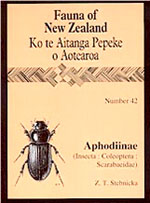
Abstract:
The Aphodiinae of New Zealand are comprehensively revised for the first time and their relationships are discussed. Twenty species in 4 tribes and 9 genera are recognised. Two new species are described (Saprosites kingsensis, Saprosites watti), and 2 new synonymies are proposed (Ataenius macilentus Blackburn, 1904 = A. brouni (Sharp, 1876); Saprosites candens (Broun, 1880) = S. distans (Sharp, 1876)). Eleven of the 20 species are introduced, 6 of them originating in Australia, 2 in America, and 1 in Africa; the other 2 are cosmopolitan anthropogenic species of European origin. Members of the genus Saprosites Redtenbacher are endemic to New Zealand, except for 1 Australian species. The species of Phycocus and Tesarius are indigenous to both New Zealand and Tasmania. The morphology and diagnostic characters of aphodiines are reviewed and illustrated in detail. A key is given for the tribes, genera, and species known from New Zealand. The biological associations, known seasonality, and geographic distribution of the species are summarised, with maps indicating locality records. The distributions of the indigenous species and their systematic affinities suggest a Gondwanan origin.
Fauna of New Zealand 39. Molytini (Insecta: Coleoptera: Curculionidae: Molytinae)
Craw, R.C., 1999.
B5, 68pp. 3,000円
モノクロ全形図3ページ、モノクロ部分図15ページ、分布地図約20掲載。
テキスト:英語
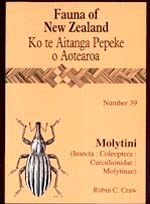
-------
Fauna of New Zealand 37. Coleoptera: family-group review and keys to identification.
Klimaszewski, J.; Watt, J.C. 1997.
B5, 199pp. 4,800円
モノクロ全形図40ページ、モノクロ部分図12ページ掲載。
テキスト:英語
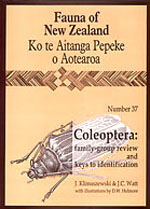
Abstract:
The 82 beetle families represented in New Zealand are reviewed. These families are briefly characterised in the phylogenetic order proposed by Lawrence & Newton (1995)(1), with family concepts similar to those defined by these authors and by Pakaluk et al. (1994)(2).
A general introduction to the New Zealand beetle fauna is given, and collecting methods are briefly discussed, and core literature is reviewed. Two alternative keys - pyramidal and linear - are provided for identification of the families, using often different character sets. Morphological features are explained, and many are illustrated. Estimated numbers of species, genera, and (where appropriate) tribes and subfamilies are given. Known distributions are discussed, and data on natural history and collecting are summarised. For each family at least one species is represented by a habitus illustration, short description, and geographic profile, and important references are listed.
Keys are provided to subfamilies of Carabidae, Leiodidae, Staphylinidae, Trogossitidae, Phloeostichidae, Scarabaeidae, Cerambycidae, Chrysomelidae, Anthribidae, Belidae, Brentidae, and Curculionidae; for some other families a substantive publication containing a key is cited.
Some 1100 currently recognised genera are recorded for New Zealand, and approximately 5580 species (>5223 native, >356 adventive) are recognised, including undescribed species housed in the New Zealand Arthropod Collection. One endemic family, Chalcodryidae, and four endemic subfamilies - Horelophinae (Hydrophilidae), Euderinae (Bostrichidae), Agapythinae (Phloeostichidae), and Cyclaxirinae (Phalacridae) - are reported. An undescribed species of Platisus from the Three Kings Islands is the only representative of the family Cucujidae in New Zealand
-------
Fauna of New Zealand 34. Anthicidae (Insecta: Coleoptera).
Werner, F.G.; Chandler, D.S. 1995.
B5, 64pp. 2,800円
モノクロ全形図3ページ、モノクロ部分図3ページ、分布地図13ページ掲載。
テキスト:英語
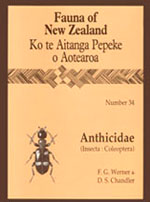
Abstract:
The Anthicidae of New Zealand are revised for the first time, and their taxonomic affinities are discussed. Twenty-six species have been found, eight of them undescribed, and eight new synonymies were discovered. Nine of these species are introduced, seven of them originating from Australia; the other two are cosmopolitan anthropogenic species. Members of genus Cotes are all restricted to New Zealand, as is the monotypic new genus Zealanthicus. The known seasonality, biological associations, and geographic distribution of the species are summarised, with maps indicating locality records. A key to their identification is given, and most species are illustrated.
------
Fauna of New Zealand 29. Cryptorhynchinae (Insecta: Coleoptera: Curculionidae).
Lyal, C. H. C.1993.
B5, 308pp. 6,000円
テキスト:英語

Abstract:
The 42 cryptorhynchine genera of New Zealand are described, figured and keyed. All 316 described species are placed in systematic context, including all junior synonyms. The morphology, distribution and systematics of the genera are discussed, and all available biological data for species are correlated. For all described species the following information is given: taxonomic history, bibliography, type repositories, type label data, distribution (in regions of New Zealand), and biological information, including any rearing records. The numbers allocated by Broun to all his cryptorhynchine species are provided, to facilitate information retrieval from some early publications. Ten new genera and 2 new species are described, 10 genera are sunk in synonymy, 112 species are placed in new combinations, 2 species thus made junior homonyms are given new names, and 34 species are placed in synonymy. Lectotypes are designated for 91 species. Two hundred and fifty-eight species are now recognised in the New Zealand fauna.
--------
Fauna of New Zealand 28. Larvae of Curculionoidea (Insecta: Coleoptera): a systematic review
May ,B.M., 1993.
B5, 226pp, 4,300円
モノクロ部分図を約1085図掲載。テキスト:英語
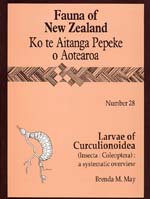
Abstract:
An overview is presented of the larvae of superfamily Curculionoidea. Their systematic arrangement follows a new 'scheme' (G. Kuschel, 1995) wherein the number of families worldwide is reduced to 6 and the number of subfamilies to 21. The data matrix underpinning this scheme includes biological and morphological character-states of larvae as well as adult weevils. In the present study an annotated list of larval character-states is given. Representative genera of all families, and of the subfamilies of Curculionidae, the largest group, are diagnosed, keyed, and illustrated. Of the 107 species reviewed, 85 occur in New Zealand (60 endemic, 25 introduced) and 22 are exotic. These latter are included for the sake of continuity or because their position is transitional.
--------
Fauna of New Zealand 26. Tenebrionidae (Insecta: Coleoptera) catalogue of types and keys to taxa
No.26 ゴミムシダマシ科
Watt, J.C., 1992.
B5, 70pp. 2,900円
モノクロ全形図7ページ掲載。テキスト:英語
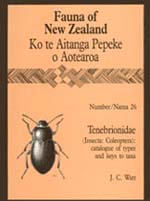
---------
Fauna of New Zealand 6. Hydraenidae (Insecta: Coleoptera).
R. G. Ordish, 1984.
B5, 64pp. 2,000円
テキスト:英語
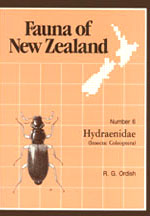
Abstract:
Thirty-two species of Hydraenidae in five genera are recognised in the New Zealand subregion. Of these, 27 are described as new species and a further two are redescribed to facilitate comparison.
Two of the genera, Homalaena and Podaena, are described as new, and together with Orchymontia Broun are regarded as comprising the primitive aquatic elements of the family which have speciated in the abundant alpine streams.
The single species of Hydraena is regarded as being much more recent, as is the only terrestrial genus, Meropathus. Keys to genera and species are given, together with habitus drawings representative of each genus and line drawings of genitalia and other diagnostic features.
Brief observations are made on morphology, biology, and phylogeny.
--------
Fauna of New Zealand 3. Anthribidae (Insecta: Coleoptera)
No.3 ヒゲナガゾウムシ科
Holloway, B. A. 1985(1982).
B5, 269pp. 4,100円
モノクロ全形図7ページ、モノクロ部分図74ページ、分布地図約50掲載。テキスト:英語
第2版発行:1985年(初版1982年)
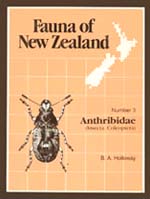
-----------------------
半翅目
Fauna of New Zealand 51. Coccidae(Insecta : Hemiptera : Coccoidea): adult males, pupae and prepupae of indigenous species
No.51 カタカイガラムシ科
Hodgson,C.J. & Henderson,R.C.,2004.
B5, 228pp. 4,700円
カラー図版10ページ(40点)、モノクロ全形図80点(雄成虫31点、蛹49点)、雄成虫検索表、蛹検索表あり。テキスト:英語

Abstract:
This contribution on soft scales (Coccidae: Coccoidea: Sternorrhyncha: Hemiptera) is divided into three parts. Part 1 describes and illustrates the adult males of 31 of the 43 indigenous soft scale species known from New Zealand. Part 2 describes and illustrates the 27 known pupae whilst part 3 describes and illustrates the 21 known prepupae. Keys to genera and species of each of these stages are provided as far as possible (some prepupae and pupae appear to be nearly identical). This is only the second study on adult males of any scale insect group for a complete geographic area and the first toinclude the pupae and prepupae.
--------
Fauna of New Zealand 50. Heteroptera (Insecta : Hemiptera): catalogue
No.50 カメムシ亜目カタログ
Lariviere,M.-C. & Larochelle,A., 2004.
B5, 330pp. 6,500円
カラー図版51ページ(192個体図示)、分布地図289点掲載。テキスト:英語
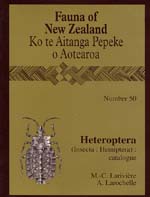
Abstract:
Heteroptera, or true bugs, are generally regarded as a suborder of the Hemiptera. There may be around 37 000 described species worldwide, and possibly another 25 000 species remaining to be described. The world fauna is divided into roughly 75 families. The number of species of better known continental faunas such as North America, Europe, or Australia, may be around 2 000 or 5 000 species. Compared with these larger regions the New Zealand fauna - currently comprising 29 families, 136 genera, and 305 species - may appear relatively small, but what it lacks in size it makes up in uniqueness, e.g., 82% of known species do not occur anywhere else in the world. From this point of view New Zealand can be regarded as a biodiversity "hot spot" for true bugs. Once described, the New Zealand fauna will probably reach 400 to 500 species. Faunal affinities are greatest with southeastern Australia.
--------
Fauna of New Zealand 41. Coccidae (Insecta: Hemiptera: Coccoidea)
No.41 カタカイガラムシ科
Hodgson,C.J. & Henderson,R.C.,2000.
B5, 264pp. 5,000円
カラー図版16ページ(64点)、雌成虫モノクロ全形図59点、雌成虫検索表あり。テキスト:英語
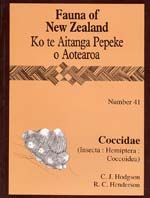
Abstract:
The adult females of all Coccidae (Hemiptera: Coccoidea) known from New Zealand are described and illustrated. In addition to the four indigenous genera previously known (Ctenochiton, Inglisia, Lecanochiton and Pounamococcus), seven new genera are described (Aphenochiton, Crystallotesta, Epelidochiton, Kalasiris, Plumichiton, Poropeza and Umbonichiton), all of which are considered to be fairly closely related to Ctenochiton and all endemic to New Zealand. Within these eleven indigenous genera, 25 new species are described and 12 species are transferred to new genera, bringing the total to 43 species. Ctenochiton elongatus Maskell is designated a nomen dubium. None of the species currently included in the genera Ctenochiton and Inglisia described from outside New Zealand are here considered to be congeneric. In addition, all known adventive (exotic) species found in New Zealand are reviewed and briefly described. Lecanium (Eulecanium) spinosum Brittin is synonymised with Parthenolecanium persicae (Fabricius), and the synonymy of Lecanium cassiniae Maskell with Saissetia oleae (Olivier) is upheld. Pulvinaria psidii (Maskell) has not been recorded in New Zealand and its inclusion in previous checklists is erroneous. Keys to adult females are included for the separation of all genera and species, and also for preliminary instar separation. Earlier work done on the superfamily Coccoidea in New Zealand is briefly reviewed and the present classification of the Coccidae and closely related families is outlined. Their biology, distribution, host-plant interactions, parasites and predators, and economic importance are also described. The current methods for collecting and mounting specimens on slides for the New Zealand Arthropod Collection are outlined, followed by a description of the morphology of adult female Coccidae, introducing the terminology used. A list of plant hosts is included in an appendix.
--------
Fauna of New Zealand Number 40. Cixiidae (Insecta: Hemiptera: Auchenorrhyncha)
No.40 ヒシウンカ科
Lariviere,M.-C. 1999.
B5, 93pp. 2,800円
モノクロ全形図12点、モノクロ部分図100点、属・種への検索表あり。テキスト:英語

Abstract:
The New Zealand Cixiidae fauna (11 genera, 25 species) is reviewed. Two new genera are described: Chathamaka gen. nov. and Parasemo gen. nov. Three new synonymies are established: Cixius interior Walker = Cixius punctimargo Walker, Malpha iris Myers = Malpha muiri Myers, Semo westlandiae Lariviere & Hoch = Huttia harrisi Myers. Cixius interior Walker is removed from the genus Koroana Myers, and Cixius rufifrons Walker is resurrected from synonymy and reinstated as the type species of Koroana. Huttia harrisi Myers is transferred to the genus Semo White. The name Cixius aspilus Walker is found to have been established on a hybrid. Eight new species are described: Aka dunedinensis sp. nov., A. rhodei sp. nov., A. westlandica sp. nov., Chathamaka andrei sp. nov., Cixius inexspectatus sp. nov. (previously recorded as C. aspilus), C. triregius sp. nov., Huttia northlandica sp. nov., and Parasemo hutchesoni sp. nov. A concise review of the taxonomy of all taxa is presented. Genera and species are keyed. Concise descriptions are provided together with illustrations emphasising the most important diagnostic features of the external morphology and male genitalia. Information is given on synonymy, type data, material examined, geographical distribution, and biology.
--------
Fauna of New Zealand Number 35. Cydnidae, Acanthosomatidae, and Pentatomidae (Insecta: Heteroptera) systematics, geographical distribution and bioecology.
No.35 ツチカメムシ科、ツノカメムシ科
Lariviere,M.-C. 1995.
B5, 111pp. 3,200円
モノクロ全形図32点、モノクロ部分図88点、分布地図18点。テキスト:英語
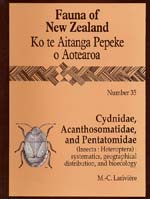
Abstract:
New Zealand's sixteen species of Pentatomoidea - representing the families Cydnidae, Acanthosomatidae, and Pentatomidae - are revised. A neotype is designated for Hypsithocus hudsonae Bergroth, and a lectotype is designated for Choerocydnus nigrosignatus F.B. White. All taxa are keyed and described, with information on synonymy, type data, material examined, geographical distribution, bioecology, and economic importance. Illustrations of important structural features, habitus drawings of the adults, and distribution maps are provided. Last-instar nymphs are described and illustrated. Comments on biodiversity and conservation values and graphs of phenological trends are provided for most of the species.
--------
Fauna of New Zealand Number 25. Cercopidae (Insecta: Homoptera)
No.25 コガシラアワフキムシ科
Hamilton,K.G.A. & Morales,C.F., 1992.
B5, 37pp. 1,500円
モノクロ全形図18点、モノクロ部分図32点、分布地図16点。種への検索表あり。テキスト:英語
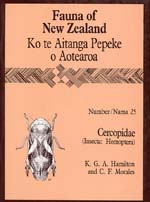
Abstract:
Fifteen species of spittlebug in four genera are recorded from New Zealand, including the following new taxa: Basilioterpa bullata n.gen. & sp. from the Three Kings Islands, Carystoterpa aurata n.sp., C. chelyon n.sp., C. ikana n.sp., C. maori n.sp., C. minima n.sp., C. minor n.sp., and C. vagan s n.sp. from mainland localities. All but the recently introduced Philaenus spumarius (Linnaeus) are endemic. Four related species on more distant islands are known: Basilioterpa fasciata (Evans) n.comb. and B. pallida (Evans) n.comb. from Lord Howe Island, Carystoterpa xenobilis Hamilton from New Caledonia, and C. fusiformis n.sp. from Norfolk Island. The last-named species, although extralimital, is described here for convenience in view of its close relationship to New Zealand taxa. The text includes notes on distribution and biology. A key to taxa is given, collection localities are mapped, and the descriptions are supported by 57 illustrations.
--------
Fauna of New Zealand Number 21 Margarodidae (Insecta: Hemiptera)
No.21 ワタフキカイガラムシ科
Morales, C.F., 1991.
B5, 123pp. 2,700円
モノクロ全形図・部分図58ページ(58点)、分布地図11点。種への検索表あり。テキスト:英語
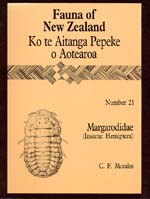
Abstract:
The endemic New Zealand coccoid genera Coelostomidia, Platycoelostoma, and Ultracoelostoma are revised. Four new species are described, and six species are redescribed, with designation of lectotypes as necessary. The immature female life stages of all ten species and the male stages of five are described and illustrated. The adult females and first instars of two introduced species of Icerya are described. Keys are given to all life stages of the endemic genera. The life histories of Coelostomidia wairoensis (Maskell) and Ultracoelostoma brittini n. sp. are described and illustrated. Brief summaries are given of the classification of the Margarodidae, their economic importance, biology, life history, host-plant associations, and collection and mounting techniques. Work done on this group in New Zealand is reviewed.
--------
Fauna of New Zealand 11. Pseudococcidae (Insecta: Hemiptera)
No.11 コナカイガラムシ科
Cox, J.M., 1987.
B5, 228pp. 4,800円
モノクロ部分図120ページ(134図)。テキスト:英語
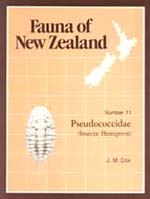
Abstract:
A total of 114 species of mealybugs are described and figured. This total comprises the 47 species hitherto known from New Zealand and 67 newly recorded ones, 61 of which are new to science. They are grouped into 28 genera, of which 8 are new- Acrochordonus, Agastococcus, Asaphococcus, Chryseococcus, Cyphonococcus, Crocydococcus, Maskellococcus, and Renicaula. Twenty-five new combinations are proposed: Asaphococcus montanus, Chryseococcus arecae, C. longispinus, Balanococcus cockaynei, B. cordylinidis, B. danthoniae, B. diminutus, B. wisei, Crocydococcus cottieri, Cyphonococcus alpinus, C. iceryoides, Maskellococcus obtectus, Paracoccus canalis, P. coriariae, P. drimydis, P. glaucus, P. insolitus, P. miro, P. zealandicus, Rastrococcus asteliae, Renicaula chionochloae, R. junci, R. raouliae, Spilococcus leucopogi, and Ventrispina otagoensis. Five synonymies are proposed: Trionymus dissimilis Brittin with Balanococcus danthoniae (Morrison), Trionymus chiltoni Brittin with Cvphonococcus alpinus (Maskell), Trionymus zealandicus Brittin with Paracoccus canalis (Brittin), Trionymus morrisoni Brittin with Paracoccus glaucus (Maskell), and Spilococcus cactearum McKenzie with S. leucopogi (Brittin). The subspecies Trionymus diminutus cordylinidis Brittin is raised to specific level, and the previously synonymised species Pseudococcus viticis Green is resurrected. The text includes a brief historical review of the work previously done on this group in New Zealand, and notes on mounting techniques, morphology, life cycle, and economic importance. Host-plant records are listed where available for each mealybug species, and the mealybugs recorded from each known host-plant are listed in an appendix.
-----------------------
双翅目
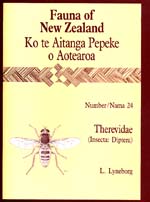
--------
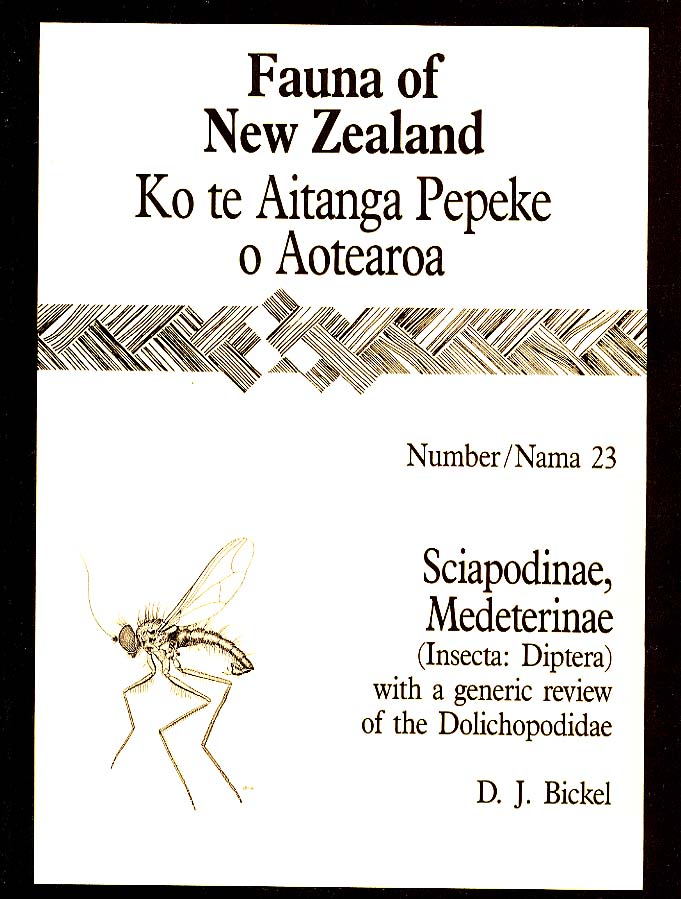
Fauna of New Zealand 20. Bibionidae (Insecta: Diptera)
No.20 ケバエ科
Harrison, R. A., 1990.
B5, 25pp. 2,000円
モノクロ全形線描図1ページ、モノクロ部分図4ページ(30図)。8分布地図掲載。テキスト:英語

Abstract:
The Bibionidae known from New Zealand are revised, and their taxonomic affinities are discussed. Eight extant species (three of them new) and one fossil species are recognised as valid. All are placed in Dilophus; the genus Philia is considered not to be represented in New Zealand. All extant species are endemic. Their known seasonality and geographic distribution are indicated, with maps showing locality records, and a key to their identification is given. Characters helpful in species discrimination are illustrated, and plant species with bibionid associations are listed.
--------
Fauna of New Zealand 8. Calliphoridae (Insecta: Diptera)
No.8 クロバエ科
James P. D., 1986.
B5, 86pp. 2,000円
モノクロ全形線描図2ページ、モノクロ部分図18ページ(140図)。テキスト:英語

Abstract:
New Zealand's Calliphoridae are revised. Keys are given to genera and species, and characters of diagnostic and systematic importance are illustrated. All taxa are fully described, and (where known) reference is made to their biology. The 7 genera included contain 54 species, of which 31 - 27 in Pollenia and 4 in Xenocalliphora - are new. Huttonophasia Curran, 1927 is synonymised under genus Pollenia Robineau-Desvoidy, 1830. Pollenia demissa var. minor Malloch, 1930 is absorbed into P. demissa (Hutton, 1901). Calliphora rufipalpis Macquart, 1851 becomes a junior synonym of Xenocalliphora hortona (Walker, 1849). Two new combinations are proposed: Gymnophania pernix Hutton, 1901 is transferred to Pollenia; and Calliphora flavipes Lamb, 1909 is moved into Xenocalliphora. Three names - Pollenia atrifemur Malloch, 1930, Pollenia demissa var. cuprea Malloch, 1930, and Calliphora nothocalliphoralis Miller, 1939 - are considered to be of uncertain identity. Lectotypes are designated for 10 nominal species: Calliphora hilli Patton, 1925; Calliphora dasyphthalma Le Guillou, 1842 (and Macquart, 1843); Pollenia auronotata Macquart, 1855; Sepimentum fumosum Hutton, 1901; Calliphora antipodea Hutton, 1902; Calliphora eudypti Hutton, 1902; Calliphora rufipalpis Macquart, 1851; and Calliphora aureopunctata Macquart, 1855. Sections by contributing authors cover three topics: immature stages and life history (B.A. Holloway); fly strike (A.C.G. Heath); and rearing (Pritam Singh). A note by K. Rognes reports the occurrence of two Pollenia species in the rudis-group, apparently recently introduced from the Northern Hemisphere.
-----------------------
膜翅目

--------

--------
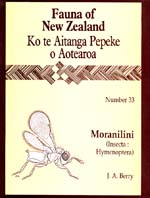
--------
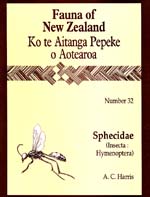
--------
Fauna of New Zealand 18. Chalcidoidea (Insecta: Hymenoptera) -Introduction, and review of smaller families-
No.18 コバチ上科
Noyes, J.S. & Valentine, E.W., 1989.
B5, 91pp. 2,600円
モノクロ線描図26ページ(126図)。テキスト:英語

Abstract:
A key is presented to the fifteen families of Chalcidoidea and the one of Mymarommatoidea known from New Zealand. Each family is characterised by a brief diagnosis. Where necessary, the known New Zealand genera of twelve families - viz Agaonidae, Aphelinidae, Chalcididae, Elasmidae, Eupelmidae, Eurytomidae, Perilampidae, Rotoitidae, Signiphoridae, Torymidae, Trichogrammatidae, and Mymarommatidae - are keyed. Each genus is diagnosed, and illustrated with a line drawing of at least one representative species. Notes are provided on distribution and hosts, and the known host associations of the New Zealand chalcidoid fauna are summarised in appendix tables. Species are placed in forty-three established genera and in a new genus proposed in the Trichogrammatidae. Bardylis Howard and Dahmsiella Hayat are synonymised with Pteroptrix Westwood (Aphelinidae).
--------
Fauna of New Zealand 17. Mymaridae (Insecta: Hymenoptera)
No.17 ホソハネコバチ科
Noyes, J.S. & Valentine, E.W., 1989.
B5, 95pp. 2,600円
モノクロ線描図34ページ(184図)。テキスト:英語
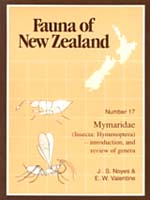
Abstract:
The family Mymaridae is briefly diagnosed, and the forty-two genera recognised as occurring in New Zealand are keyed for both sexes. Each genus is diagnosed and illustrated by line drawings of at least one representative species, and notes are provided on distribution, biology, and the major taxonomic references. The following seventeen genera and species are described as new: Acmotemnus luteiclava, Allanagrus magniclava, Allarescon ochroceras, Apoxypteron grandiscapus, Ceratanaphes monticola, Cybomymar fasciifrons, Dorya pilosa, Haplochaeta mandibularis, Ischiodasys occulta, Mimalaptus obscurus, Neserythmelus zelandicus, Paracmotemnus potanus, Paranagroidea verrucosa, Pseudanaphes hirtus, Scleromymar breve, Steganogaster silvicola, and Zelanaphes lamprogonius. A further three genera are recognised as new but are not formally described. Dahmsia Doutt is synonymised with Anagroidea Girault, and Douttiella Annecke with Cleruchus Enock.
--------
Fauna of New Zealand 15. Ambositrinae (Insecta: Hymenoptera: Diapriidae)
Naumann, I. D., 1988.
B5, 165pp. 4,000円
モノクロ全形線描図5ページ(10個体)、モノクロ線描図20ページ(263図)。44分布地図、電子顕微鏡写真36ページ(160枚)掲載。テキスト:英語

Abstract:
The genera and species of Ambositrinae occurring in New Zealand are described and illustrated, and the known distribution of all species is mapped. Keys to the subfamilies of Diapriidae and the genera of Ambositrinae occurring in New Zealand are given. The phylogeny of the world genera of Ambositrinae, modifications of the first post-petiolar tergite, wing reduction, biology, and host associations are discussed. An abnormally developed cyclopic male is described. The biogeographical relationships of New Zealand's Ambositrinae are reviewed in the context of continental drift theory. Speciation and present-day distributions of species within New Zealand are explained by reference to Tertiary changes in land area and glaciation. Four genera are redescribed: Pantolytomyia Dodd, 1915; Diphoropria Kieffer, 1905; Parabetyla Brues, 1922; Betyla Cameron, 1889 (=Tanyzonus Marshall, 1892). Three new genera - Archaeopria, M?oripria, Zealaptera - are erected. Parabetyla spinosa Brues, 1922 and Betyla fulva Cameron, 1889 (=Tanyzonus bolitophilae Marshall, 1892) are redescribed, and 33 new species are described: Archaeopria eriodes, A. pelor, A. pristina; Pantolytomyia flocculosa, P. tungane, P. takere, P. polita, P. insularis, P. wairua, P. taurangi; Diphoropria sinuosa, D. kuscheli; M?oripria verticillata, M. annettae, M. earlyi, M. masneri; Parabetyla tika, P. pipira, P. ngarara, P. pokorua, P. nauhea, P. tahi; Zealaptera chambersi; Betyla prosedera, B. auriger, B. thegalea, B. rangatira, B. karamea, B. eupepla, B. tuatara, B. wahine, B. paparoa, B. midas. Unassociated males representing 2 species of M?oripria, 2 species of Parabetyla, and 7 species of Betyla are diagnosed briefly.
--------
Fauna of New Zealand 13. Encyrtidae (Insecta: Hymenoptera)
No.13 トビコバチ科
Noyes, J. S., 1988.
B5, 188pp. 4,500円
モノクロ線描図44ページ(383図)。テキスト:英語

Abstract:
Thirty-five genera and 67 species of Encyrtidae are recorded from New Zealand, including the adjacent subantarctic islands. Of these, four of the genera - Notodusmetia, Odiaglyptus, Zelaphycus, and Zelencyrtus - are new, as are 32 of the species. A further genus and three species are recognised but not named. The following new synonymies are proposed: Kakaoburra with Subprionomitus; Anarhopus and Zealandencyrtus with Tetracnemoidea; Quaylea aliena and Cerchysius whittieri with Coccidoctonus dubius; Litomastix maculata with Copidosoma floridanum; Eucomys proserpinensis and E. hortensis with Encyrtus infelix, Eucomys argenticoxa, E. hibisci, E aurantifasciata, and E. argentiscapus with Encyrtus lecaniorum; and Antipodencyrtus procellosus and Zealandencyrtus yasumatsui with Tetracnemoidea bicolor. Five new combinations are proposed: Copidosoma floridanum, Subprionomitus angeliconini, Subprionomitus ferus, Tetracnemoidea sydneyensis, and Zelaphycus aspidioti. A lectotype is designated for Cheiloneurus gonatopodis, and the subtribe Mayridiina is given tribal status. The text includes a diagnosis of the Encyrtidae; a summary of the biology and life history of the family; notes on the use of encyrtids in biological control in New Zealand; methods of collecting and preserving encyrtids; a discussion of the probable origins and distribution of the New Zealand fauna; keys to the genera and species; descriptions or redescriptions of all the taxa; notes on their systematic relationship with taxa in other parts of the world; notes on the distribution of each species; and, where available, information on their hosts. Sufficient illustrations are included to facilitate recognition of taxa and discrimination of diagnostic characters.
--------
Fauna of New Zealand 12. Pompilidae (Insecta: Hymenoptera)
No.12 ベッコウバチ科
Harris, A.C., 1987.
B5, 154pp. 4,000円
モノクロ全形線描図20ページ(158個体)、モノクロ部分図36ページ(236図)。16分布地図掲載。テキスト:英語

Abstract:
Eleven species of Pompilidae are recognised from New Zealand, of which ten are endemic. The four genera belong to two subfamilies: Pepsinae - Cryptocheilus Panzer, Priocnemis Schi?dte, Sphictostethus Kohl; and Pompilinae - Epipompilus Kohl. Chrysocurgus Haupt and Trichocurgus Haupt are removed from synonymy with Chirodamus Haliday. Trichocurgus is reinstated as a subgenus of Priocnemis, and Chrysocurgus is synonymised with Sphictostethus, which is restored to generic status within tribe Pepsini. Ten specific names are placed into synonymy. Priocnemis (Trichocurgus) ordishi, Priocnemis (T.) crawi, and Sphictostethus calvus are described as new. The sexes are correctly associated for all species, most for the first time. All previously known species are redescribed, morphological structures of adults and larvae are illustrated, and keys are given to tribes, genera, and species for adults (both sexes) and larvae. Taxonomic decisions are supported by data on biology, behaviour, and distribution. Behaviour, nesting cycles, life histories, and final-instar larvae are described for all species. Three species nest above ground. Of these, Epipompilus insularis Kohl oviposits directly on spiders, usually in situ within their retreats, without making nests; Sphictostethus fugax (Fabricius) is a mud-dauber favouring beetle pupal chambers in trees; and Sphictostethus calvus nests in rotting logs. Priocnemis (Trichocurgus) nitidiventris (Smith) makes single-celled nests exclusively in sand. The other species nest below ground in diverse habitats, making either single-celled nests or multi-celled nests which in some species may be used by many generations over a period of years. Geographical variation (including mimicry and parallel ecophenotypical colour variation) is described, and distributions of all species are indicated. In four species melanism varies clinally from Spirits Bay (34°27'S) to Port Pegasus, Stewart Island (47°14'S) in relation to climatic factors. Varying degrees of melanism were induced experimentally in some species (but not in others) by lowering the temperatures experienced by the pupa. Abrupt disruptions in the clines occur at the sites of past and present geographical barriers; hence seven subspecies or races can be recognised, but these are not named. Extralimital relationships of the New Zealand species are indicated. Cryptocheilus australis (Guerin) was introduced from Australia in the past three decades. E. insularis has strong Australian affinities, and the three Sphictostethus species are closely related to species in Tasmania and Chile. Extensive host records are given for all species.
-----------------------
鱗翅目
Fauna of New Zealand 54. Hierodoris (Lepidoptera, Gelechiodea: Ocecophoridae)
No.54 Hierodoris(マルハキバガ科)
Hoare, R.J., 2005.
B5, 102pp. 3,400円
カラー全形図7ページ(42個体)、モノクロ部分図28ページ(138図)。18分布地図掲載。テキスト:英語

Abstract:
An overview of New Zealand Oecophoridae is presented, and a new genus-group, the ‘Hierodoris group’, is defined. The systematic placement of this group is discussed. New Zealand oecophorid genera not assigned to the Hierodoris group are assigned to the Wingia, Chezala, and Barea groups of Common. Stathmopodinae are excluded from Oecophoridae.
The endemic New Zealand genus Hierodoris Meyrick is revised. The genus is fully redescribed, and 18 species are recognised, including 8 new species: H. gerontion, H. huia, H. pachystegiae, H. polita, H. sesioides, H. s-fractum, H. torrida, and H. tygris. Gymnobathra squamea Philpott is transferred to Hierodoris. Coridomorpha Meyrick is sunk as a junior subjective synonym of Hierodoris, and H. chlorobela Meyrick as a junior subjective synonym of H. illita (Felder & Rogenhofer). All species are fully described and adults illustrated in colour; male genitalia are illustrated for all species and female genitalia for all except H. sesioides. Larvae and pupae are described for the species in which they are known. Information is given on biology, distribution, and conservation status, with 5 species considered potentially threatened at the national level: H. huia, H. polita, H. sesioides, H. stella, and H. tygris. Two species-groups are recognised: the Hierodoris iophanes group including H. iophanes, H. frigida, H. polita, H. torrida, and H. huia, and the Hierodoris illita group including all the remaining species.
--------
Fauna of New Zealand 49. Lithinini (Insecta: Lepidoptera: Geometridae: Ennominae)
No.49 Lithinini(シャクガ科エダシャク亜科)
Weintraub, J.D. & Scoble, M.J., 2004.
B5, 48pp. 2,300円
モノクロ全形図5ページ(26個体)、モノクロ部分図8ページ(43図)。8分布地図掲載。テキスト:英語
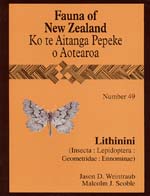
Abstract:
The New Zealand Lithinini are reviewed, with a general discussion of morphology and natural history. A key is provided to the eight species, representing three genera. The New Zealand fauna is wholly endemic, with affinities to Southern Hemisphere genera that occur in temperate Australia and Tasmania. Sarisa (monotypic), Sestra (two species), and Ischalis (five species) are treated in detail. Ischalis dugdalei n. sp. is described from the South Island. Comprehensive distribution data are provided for all taxa. Host plant association data and information on immature stages are reviewed for all New Zealand genera and summarised.
--------
Fauna of New Zealand 30. Hepialidae (Insecta: Lepidoptera)
No.30 コウモリガ科
Dugdale, J., 1994.
B5, 164pp. 3,600円
モノクロ全形描画図12ページ(約70個体)、モノクロ部分図51ページ(約270図)。27分布地図掲載。テキスト:英語
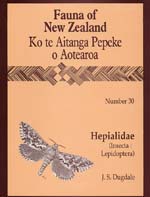
Abstract:
New Zealand's ghost moths and porina moths are revised. Seven genera are recognised: Aenetus, Aoraia, Cladoxycanus, Dioxycanus, Dumbletonius, Heloxycanus new genus, and Wiseana. Twenty-seven species are recognised, of which Aoraia aspina, A. flavida, A. hespera, A. insularis, A. lenis, A. macropis, A. oreobolae, A. orientalis, A. rufivena, and Heloxycanus patricki are new. Dumbletonius sylvicola Dugdale, 1988 is reduced to synonymy with D. unimaculatus (Salmon, 1948). Morphology of adult, pupa, larva, and male genital musculature is reviewed, along with relationships and biology, including phenology and biotopes. Keys to taxa are given for all life stages authenticated to species, and each genus and species is defined. Habitus and structures are illustrated for each species, and distributions are mapped. Four lineages are represented : Aenetus, shared with Australia; Aoraia and Cladoxycanus, two unrelated terminal taxa; and the 'Oxycanus' group, or porina moths, with an Australian sister-group. Wiseana includes significant pasture pests, and recognition of species has been supported by electrophoretic studies conducted elsewhere; W. fuliginea has been 'rediscovered' through these studies.
--------
Fauna of New Zealand 16. Nepticulidae (Insecta: Lepidoptera)
No.16 モグリチビガ科
Donner, H. & Wilkinson, C., 1989.
B5, 88pp. 2,500円
モノクロ全形線描図5ページ(16個体)、モノクロ部分図28ページ(84図)。27分布地図掲載。テキスト:英語
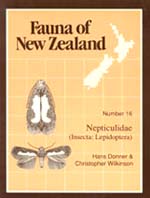
Abstract:
Twenty-eight species of Nepticulidae are here recognised in the New Zealand fauna, 14 of them new. All are placed in genus Stigmella Schrank, and all except microtheriella Stainton are considered to be endemic. Two new synonymies are proposed: perissopa Meyrick with cypracma (Meyrick); and erechtitus Watt with ogygia Meyrick. Species identification leans heavily upon characters of the genitalia, and this is reflected in the keys to adults, the descriptions, and the illustrations; for twenty-six species genitalia are figured for the first time. The leaf-mining habit of the larvae is discussed in some detail, and the diagnostic value of aspects of the host-plant / larva association - such as mine morphology and host-plant specificity - is explained and illustrated. There is evidence of mining in New Zealand leaf fossils of middle Miocene age. The history of study of New Zealand's nepticulid fauna is reviewed, and the background to the present study is described. Criteria for the recognition of all life stages are described, and advice is given on methods of collection, rearing, and preparation of specimens. Records of confirmed associations between Stigmella species and foodplants are catalogued in an appendix. Drawings of adult facies are given for fourteen species.
--------
Fauna of New Zealand 14. Lepidoptera -annotated catalogue and keys to family group taxa-
Dugdale, J. S., 1988.
B5, 262pp. 4,800円
モノクロ部分図24ページ(137図)。テキスト:英語

Abstract:
This annotated synonymic catalogue represents an attempt to verify and define nomenclaturally the species of Lepidoptera recorded from New Zealand since 1769. It is based on a thorough re-examination of type material and recorded data. Types of nearly all nominal species held by overseas institutions were examined during 1980-81. Of the 2150 published names, type specimens of about 1570 (73%) are in the Northern Hemisphere; over 1460 of these (68%) are at the British Museum (Natural History). The 1761 recognised species are assigned to modern family-group concepts, and are listed under superfamilies, which are placed in 'systematic' sequence. Within each superfamily, all subordinate taxa are listed alphabetically. Synonyms are listed in date order. For each species and synonym, basic nomenclatural data concerning the type locality, collector, type status, condition of specimens (if noteworthy), and repository are given. Where relevant, species are cross-referenced to G.V. Hudson's illustrated monographic works. References are also given, as appropriate, to genitalia descriptions by A. Philpott and to first records of adventive species. Any additional remarks are given under 'Notes' for a taxon entry. Names are proposed for three misidentified species, i.e., for which invalid concepts of previously described species have entered current usage: Dumbletonius sylvicola for Trioxycanus enysii (not of Butler); Heterocrossa rubophaga for H. adreptella (not of Walker); and Stathmopoda horticola for S. skelloni (not of Butler). Brief introductory sections outline the history of study, classification, and composition of New Zealand's lepidopteran fauna. Keys to superfamilies, families, and (where possible) subfamilies are presented, with illustrations of diagnostic features. There is also a key to the brachypterous Lepidoptera. These keys conform to the New Zealand situation; any wider relevance is coincidental. The 69 species reported from the Kermadec Islands are excluded from the main catalogue, but are listed in an appendix. There are over 700 references.
-----------------------
その他の昆虫

--------

--------

--------
Fauna of New Zealand 19. Mantodea (Insecta) with a review of aspects of functional morphology and biology.
No.19 カマキリ目
Ramsay, G. W. 1990.
B5, 96pp. 2,600円
モノクロ全形図2ページ、モノクロ部分図16ページ、電子顕微鏡写真9ページ掲載。テキスト:英語
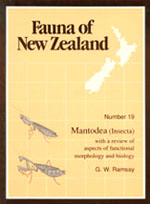
Abstract:
Orthodera novaezealandiae (Colenso) (Orthoderinae) and Miomantis caffra Saussure (Mantinae) are the only two species of mantid established in New Zealand. O. novaezealandiae is taxonomically very close to some populations of O. ministralis (Fabricius) in Australia, with which it has generally been regarded as synonymous; it is here reaffirmed as a distinct species. M. caffra, a southern African species, was discovered in New Zealand in 1978 and is now established around Auckland and spreading. The taxonomy and status of these species are outlined, and characters distinguishing between them in all life stages are tabulated and illustrated. Morphology and life history are described in detail, with particular attention to variation in wing venation and genital characters. The history of mantid classification is discussed, and several aspects of mantid morphology and biology are critically reviewed, from a worldwide perspective, in the light of a detailed examination of the New Zealand species. These are: (a) femoral brush; (b) wing morphology; (c) pterostigma; (d) coloration; (e) stridulation; (f) acoustic sensitivity; (g) defence behaviour; (h) regeneration; (i) predation (on mantids); (j) parasitism; (k) pathology; (l) diet. SEMs show details of the femoral brush, pterostigma, and cyclopean ear (acoustic receptor).
--------
Fauna of New Zealand 10. Tubulifera (Insecta: Thysanoptera)
No.10 クダアザミウマ亜目
Mound, L.A. & Walker, A.K., 1986.
B5, 140pp. 3,600円
モノクロ全形図2ページ、モノクロ部分図44ページ(280図)。テキスト:英語
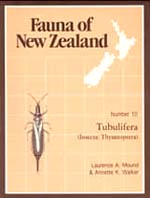
Abstract:
Sixty-eight species of Tubulifera in 29 genera are recorded from New Zealand, including the following new taxa: Cryptothrips okiwiensis; Heptathrips cottieri, H. cumberi, H. kuscheli, H. tillyardi; Nesothrips alexandrae, N. pintadus; Ozothrips tubulatus, O. vagus; Apterygothrips collyerae, A. kohai, A. sparsus, A. viretum; Azaleothrips neatus; Deplorothrips bassus; Haplothrips salicorniae; Hoplandrothrips choritus, H. ingenuus, H. vernus; Hoplothrips anobii, H. kea, H. oudeus; Lissothrips dentatus, L. dugdalei, L. gersoni; Podothrips orarius, P. turangi; Psalidothrips moeone, P. tane, P. taylori; Yarnkothrips kolourus. Seventeen species have been introduced to New Zealand from Australia, but only 8 species appear to have been introduced from other parts of the world. Two New Zealand species are now widespread elsewhere, Aesothrips propinquus and Hoplothrips semicaecus. Thus, 43 of the 68 species of Tubulifera appear to be endemic to New Zealand - a higher proportion than in the Terebrantia. Two subfamilies are recognised, the Idolothripinae and Phlaeothripinae; the available tribal classification of the second group is discussed and rejected. The text includes notes on distribution and biology, and discusses life histories, phylogeny, morphology, and technical methods. A key to taxa is given, and the descriptive notes are supported by some 300 illustrations.
--------
Fauna of New Zealand 9. Protura (Insecta)
No.9 カマアシムシ目
Tuxen, S. L., 1986.
B5, 50pp. 2,000円
モノクロ図版1ページ、モノクロ部分図18ページ(152図)。14分布地図掲載。テキスト:英語
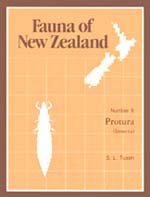
Abstract:
Sixteen species of Protura in ten genera are recognised from New Zealand, of which seven species and two genera are new to science. Fifteen species are fully described and illustrated; the sixteenth, known from a single immature specimen, is of indeterminate identity. Keys are given to the families of Protura and to the species known from New Zealand. The morphology and diagnostic characters of proturans are reviewed in some detail, and illustrated with scanning electron micrographs, as a further aid to identification. The known distribution of the species recorded here, and their systematic affinities, suggest a Gondwana origin for all but a few that are clearly recent introductions from Europe. Brief mention is made of the history of study of Protura in New Zealand, their life cycle and biology, and techniques used in their collection, preparation, and study.
---------------------